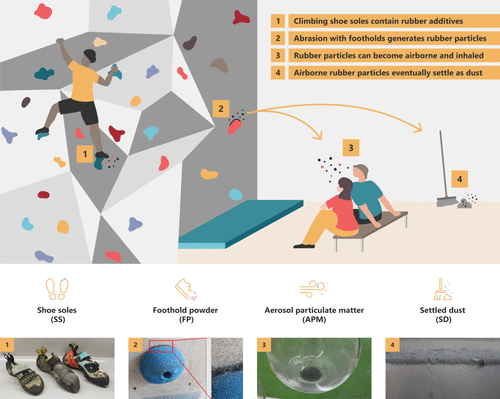The specialized rubber soles of climbing shoes are releasing potentially harmful chemicals into the air of indoor climbing facilities at levels comparable to busy roadways in major cities, according to groundbreaking research published April 29 in Environmental Science and Technology Air.
Researchers from the University of Vienna and EPFL Lausanne discovered that as climbers scale walls, their shoes leave behind rubber particles containing various chemical additives, which can become airborne and be inhaled by both recreational climbers and facility employees.
“The soles of climbing shoes are high performance products, just like car tires,” explained study first author Anya Sherman, an environmental scientist at the Centre for Microbiology and Environmental Systems Science at the University of Vienna.
The research team analyzed 30 different climbing shoe models, as well as air samples and dust from nine indoor climbing facilities across Austria, Switzerland, France, and Spain. They identified 15 rubber-derived compounds (RDCs) in the shoe samples, including chemicals like 6PPD – a rubber stabilizer whose transformation product has been linked to salmon deaths in rivers.
What surprised researchers most was the concentration of these chemicals in the air. “The levels we measured are among the highest ever documented worldwide, comparable to multi-lane roads in megacities,” said corresponding author Thilo Hofmann, Professor of Environmental Geosciences at the University of Vienna.
The rubber particles come from the intentional abrasion of shoe soles during climbing. This rubber dust accumulates on climbing holds and mats, where it can be disturbed when climbers brush holds or fall onto mats, causing particles to become airborne. Analysis showed the concentration of these chemicals in some facilities exceeded exposure levels from other known sources.
For regular climbers and especially employees spending hours in these facilities, the estimated daily intake of certain compounds was calculated to be up to 29 nanograms per kilogram of body weight per day – significantly higher than the exposure levels measured for people working near industrial sites or busy roads in previous studies.
While the immediate health implications remain unclear, the researchers are concerned about potential long-term effects. “These substances do not belong in the air we breathe. It makes sense to act before we know all the details about the risks, especially with regard to sensitive groups such as children,” Hofmann emphasized.
The study highlights a previously unknown route of human exposure to these chemicals, potentially affecting millions of people worldwide who participate in indoor climbing. In the United States alone, an estimated 4.4% of the population visited indoor climbing facilities in 2018, with about 20% being regular visitors who spend several hours multiple times per week in these environments.
The researchers noted that climbing facility operators were cooperative and interested in improving air quality. Potential solutions include better ventilation systems, more thorough cleaning practices, and designing climbing shoes with fewer harmful additives.
“It is essential to switch to sole materials with fewer harmful substances,” said Hofmann, adding that manufacturers are currently not sufficiently aware of the problem. The rubber they purchase for soles contains a “cocktail of undesirable chemicals.”
Despite the findings, Sherman remains positive about the sport: “I will continue to climb, and I am confident that our research will contribute to better conditions in climbing gyms.”
If our reporting has informed or inspired you, please consider making a donation. Every contribution, no matter the size, empowers us to continue delivering accurate, engaging, and trustworthy science and medical news. Independent journalism requires time, effort, and resources—your support ensures we can keep uncovering the stories that matter most to you.
Join us in making knowledge accessible and impactful. Thank you for standing with us!

